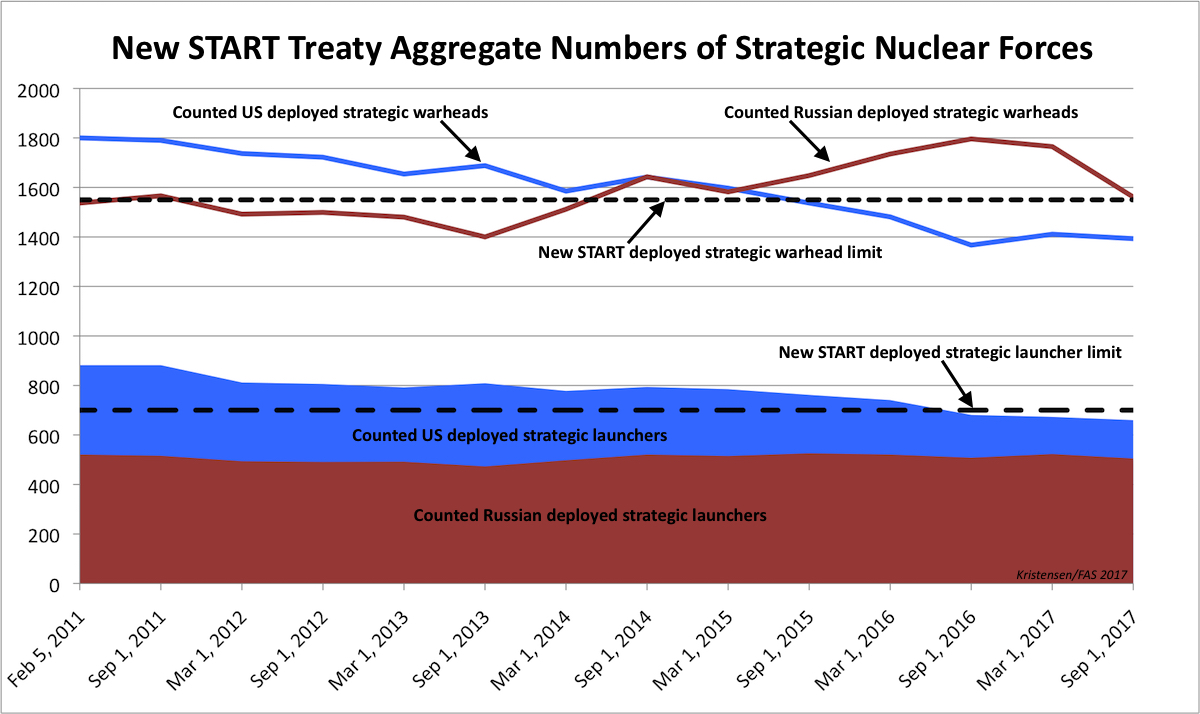New START Data: Russia Slashes Deployed Warheads, US Reaches Limits
By Hans M. Kristensen
The United States has now reached the limits for all three weapons categories under the New START treaty.
The latest data published by the State Department shows that the United States for the first time since the treaty entered into force in 2011 has reached the limit of 800 deployed and non-deployed strategic launchers. The 660 deployed launchers are also below the treaty limit of 700 and the 1,393 deployed warheads is well below the limit of 1,550. As such, the United States is now technically in compliance with the treaty.
The latest US reductions are the result of denuclearization of bombers and reduction of launch tubes on the Ohio-class submarines.
The data shows that Russia has reduced its deployed strategic warheads by 235 in the past 12 months and is now only 11 warheads above the New START treaty limit of 1,550 warheads to be achieved by February 2018. Russia is already below the treaty limit on deployed launchers as well as deployed and non-deployed launchers.
Russia’s increase in deployed strategic warheads between 2013 and 2016 triggered widespread claims by defense hawks that Kremlin was building up its nuclear forces. As I previously pointed out, that was wrong and the result of temporary fluctuations in the Russian force structure. Russia is modernizing, not increasing, its nuclear arsenal.
The Bigger Picture
The latest data shows that the United States has a significant advantage over Russia in deployed strategic launchers; 660 versus 505. The 155-launcher disparity means Russia emphasizes multiple warhead loading on its ICBMs while the United States has downloaded its ICBMs to carrying only a single warhead each. A future follow-on treaty will need to address this disparity, which is unhealthy for long-term strategic stability.
Although the United States and Russia are now at, near, or below the limits of the New START treaty, the warheads counted by the treaty only constitute a small fraction of the two countries’ total warhead inventories.
We estimate that Russia has a military stockpile of 4,300 warheads with more retired warheads in reserve for a total inventory of 7,000 warheads. For its part, we estimate the United States has a military stockpile of 4,000 warheads with more retired warheads in reserve for a total inventory of 6,800 warheads.
These arsenals are vastly in excess of the nuclear force levels maintained by other nuclear-armed states and constitute more than 90% of the world’s combined inventory of nearly 15,000 nuclear warheads.
Moreover, the New START treaty does not limit the 2,350 non-strategic nuclear warheads we estimate that Russia and the United States have in their arsenals combined. Both sides are modernizing their non-strategic nuclear forces.
Finally, the New START treaty expires in 2021 unless extended for another five years. The Trump administration has previously indicated opposition to extending the treaty, although recent discussions with Russia may seek to change that. A follow-on treaty seems unlikely given the current political climate but could easily be achieved by reducing the excess nuclear forces of Russia and the United States.
This publication was made possible by a grant from the Carnegie Corporation of New York, the New Land Foundation, and the Ploughshares Fund. The statements made and views expressed are solely the responsibility of the author.
While it is reasonable for governments to keep the most sensitive aspects of nuclear policies secret, the rights of their citizens to have access to general knowledge about these issues is equally valid so they may know about the consequences to themselves and their country.
Nearly one year after the Pentagon certified the Sentinel intercontinental ballistic missile program to continue after it incurred critical cost and schedule overruns, the new nuclear missile could once again be in trouble.
“The era of reductions in the number of nuclear weapons in the world, which had lasted since the end of the cold war, is coming to an end”
Without information, without factual information, you can’t act. You can’t relate to the world you live in. And so it’s super important for us to be able to monitor what’s happening around the world, analyze the material, and translate it into something that different audiences can understand.
